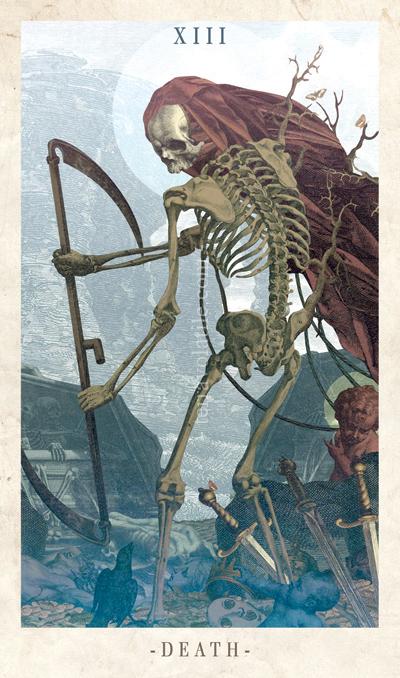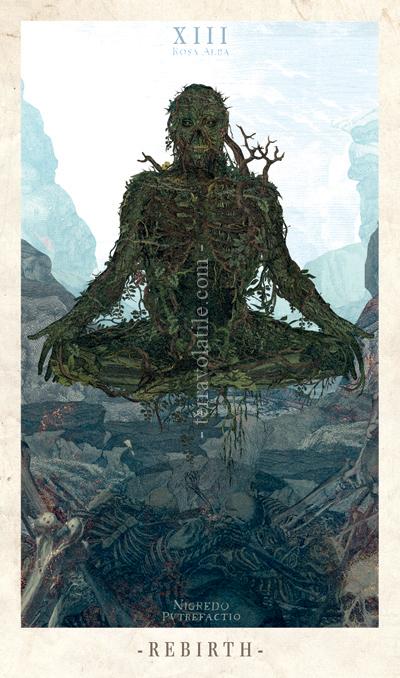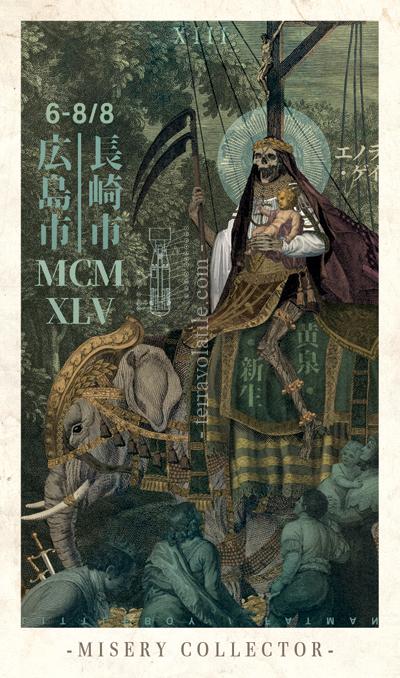
Symbology
This arcanum is considered the most feared card in the entire deck, maybe because of the central figure, the Grim Reaper, which was a synonym of mortality in the Middle Ages.
Nevertheless, the Death card generally does not mean physical death or absolute annihilation. Note that the tarot follows a certain sequence and this card is not the last one, there is much more beyond it, much more to come.
Following the twelfth arcanum, which represents a complete cycle and the idea of stability, the thirteenth card comes as a rupture in that cycle, breaking all that is known and expected and shoving us inside the sphere of the unknown.
Death is usually related to spiritual transformation, an end of a cycle. That does not necessarily signify that it is a card of bad omens, quite the contrary. Death is a point of rupture, of evolution, of starting anew. Our lives are made of cycles: while some might be filled with good fortune, other cycles make us feel relieved once they are over.
The deeper changes that come with Death appear in our lives unexpectedly. This sudden experience may affect us tremendously, destroying old values and beliefs; but we all need to close chapters and start new ones.
This powerful symbol from medieval iconography consists of an animated skeleton walking over a pile of money, crowns, swords and other different objects. That means that Death does not distinguish between social classes or faiths, for every living thing must submit to it.
The scythe, held with both hands, gives us the impression of circular motion. This kind of clockwise movement is also related to an apparently irreversible succession from the past, through the present, and into the future, exactly mimicking the notion of Time (Chronos from classical mythology).
There is a latin proverb “Tempora mutantur, nos et mutamur in illis” which means “Times change, we change with them”. Time has indeed a major influence on ourselves. There is no way to escape it nor to stand (for very long) against the changes that come with it. Time forces us to adapt and progress.
Death emerges the same way, demanding an adjustment in our lives that is crucial for future events.
“It is not the most intellectual of the species that survives; it is not the strongest that survives; but the species that survives is the one that is able to adapt to and to adjust best to the changing environment (…)”. Charles Darwin in Origin of Species (1859).
This card evokes a large work of cleansing and purification, so the skeletal figure represents our own foundations. Death represents ourselves, scything everything that is obsolete in our hearts and minds.
Astrologically speaking, Death is related to Scorpio which is ruled by the element of Water. Water, as a symbolic agent of Death, dissolves the shapes of bodies, recombining elements in order to create new forms of life.
In alchemy, this operation is called Putrefaction which consists of the destruction of present matter, reducing it to its essence (like the skeleton) so it can be reborn as a completely new being or material. This alchemical process is symbolically portrayed in this card by the black crow at Death’s feet.
“In nature nothing is created, nothing is lost, everything changes.” – Antoine-Laurent de Lavoisier.
Upright Meaning and Interpretation
Major Change, Renewal, Transition.
The card of The Hanged Man wanted us to have a period of pause. As a consequence, Death appears as an emissary of a new chapter in our lives. It means that an important phase in our lives is about to end, giving birth to a new one.
Adapting to this new chapter can be difficult, most people go through an adjustment period similar to when you visit a foreign country. Once this “culture shock” is understood and you start to feel more comfortable in your new “skin”, everything around you seems to be more peaceful.
To help in this harsh process, you should get rid of old emotional (or even physical) baggage that makes you heavier. By doing this deep purge you will find more space for new experiences and memories.
Reversed Meaning and Interpretation
Resistance to Change, Attachment to the Past, Stagnation.
Death in reverse can mean that a big transformation is about to happen in your life but you are resisting it. The more you refuse to let this change happen, the more stagnated the waters around you become, and that is not good for anybody. This great sense of inertia drives you through a feeling of negativity, as if nothing has been accomplished.
You are probably afraid to let go because you do not want to suffer; but if you hold it for much longer, it will cause you more pain, both physical and emotional.
The past has a tremendous influence in your life so you must find a way to put it behind. Only then you are ready to embrace new opportunities. Remember that the butterfly was once a caterpillar: by accepting a deep metamorphosis it allowed itself to be reborn as a wonderful being.

Alternative Card I:
Rebirth
In this card we explore the alchemical stage of Nigredo and the process of Putrefaction. The traditional skeleton, once a man, is reborn now as a plant-man, a new purified being.
“Putrefaction is so effective that it destroys the old nature and form of the rotting bodies; it transmutes them into a new state of being to give them a totally new fruit. Everything that has life, dies; everything that is dead putrefies and finds a new life.” Antoine-Joseph Pernety, Dictionnaire Mytho-Hermétique (1758), p. 419.
His meditation position represents a spiritual transformation and defines the balance between the material body and spiritual body. Every new cycle in our lives brings us the opportunity and challenge to become more purified and balanced. The figure was inspired by the Swamp Thing comics, in which a scientist died in the swamps of Louisiana to be reborn from the waters as a plant-creature.

Alternative Card II:
Misery Collector
Misery Collector shows an extravagant portrait of Lady Death holding a child as a symbol or rebirth or resurrection. She is portrayed as an unstoppable force. Riding a huge elephant, she tramples over any obstacle that might come her way. We chose this version to represent the most dramatic and negative features of Death, within a very dark atmosphere that resembles the arrival of the last horseman of the Apocalypse.
At the left side we see references to the atomic bombs and the cities of Nagasaki and Hiroshima (in Kanji characters). Therefore, for this alternative card, we wanted to convey the tragic changes and dramatic transformations a society endures after a war, even more a bombing attack like the one that occurred in Japan on June 6, 1944. For this version of Death, we thought about the two bombs, Fat Man and Little Boy, whose ridiculous names grotesquely describe the disturbing perversion and stupidity of war. The figure itself shows us a mysterious and rotting skeleton taking a baby away. Bearing no responsibility for what happened in Japan, it collects the remains as scavengers do.
Most of all, this is a card that makes us see the impact of our actions and choices. After all this, we really need a rebirth, as we can read in the Kanji characters on the front of the saddle.
We must say that this alternative version of Death is not the most accurate choice to build your own deck. But in the end, it is up to you.
